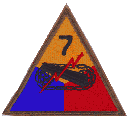Click on images to see them full size.

Aerial view of Sillegny, looking west (full image 38 MB)
|

|
Pages 165-166 - Prior Events in near approach toward Sillegny: 16 September 1944
Early on 16 September the leading elements of the CCR column (Col. Pete T. Heffner) which had crossed on the previous day began an attack to break out to the east along the Lorry-Sillegny road. General Silvester intended to bring CCA in on the left of CCR, as it arrived in the bridgehead, and launch the two combat commands in attack along parallel routes. CCB was ordered to join the rest of the division, as soon as disengaged, and follow behind the artillery of the leading combat commands as a division rear guard. The line of departure for the 7th Armored Division attack was not marked too specifically on the ground, but generally followed the forward slope of the ridge line between Fey and Mardigny. In the plans prepared by the Third Army staff the 7th Armored Division would skirt the "known" forts south of Metz, cross the Seille River, then begin a wheel to the northeast in the neighborhood of Verny, cross the Nied River, and circle to the rear of Metz, with the inside column of CCA passing about three miles from the heart of the city. While this envelopment was in progress CCR, on the right, would be responsible for guarding the open flank, and would be covered in turn by a cavalry screen thrown out to the east. Such a scheme of maneuver was daring enough to suit even General Patton, but its successful execution hinged on numerous and unpredictable factors. Intelligence reports already carried information that the Germans were building a new line of defense across the Seille River, only six miles east of the Moselle. Once the Seille line was breached the 7th Armored Division columns would have to pass under the guns of the Metz exterior forts, clustered around Verny and Orny. If the weather continued poor, little help could be expected from the air force, and the armored columns would be unable to deploy across country off the main hard-surface highways. In any case the road net was limited, and it was known that the enemy had taken the precaution of emplacing much reserve artillery along the roads leading east.
CCR got a taste of the difficulties involved in this armored advance almost as soon as it began the attack. The Germans had dug in along the Lorry-Sillegny road and occupied a large woods astride the highway. One task force (Lt. Col. J. A. Wemple) of CCR, having fought its way through the woods and into the clear, was driven back to the shelter of the trees by accurate shelling from Sillegny. CCA, which had crossed the Moselle in the early morning, joined the attack at 1400 but was compelled to use the 48th Armored Infantry Battalion (Colonel Chappuis) instead of its tanks because of the fog and the slippery condition of the slopes on the line of departure. Some of the CCA tanks even had to be winched over the crest of the ridge in order to reach attack positions. As the armored infantry started down the slope toward the hamlet of Vezon, they were hit immediately by artillery fire plowing into the flank from the Verdun Forts in the north. Colonel Chappuis sideslipped his rifle companies behind a spur of the main ridge which jutted east between Lorry and Marieulles, and shifted the direction of the attack toward the latter town. Hill 396, taken by the 10th Infantry the day before, gave observation from which artillery officers directed a concentration of thirteen field artillery battalions on Marieulles preparatory to the assault. But, when the fire lifted, the Germans crawled out of cellars and foxholes, the guns behind the town opened up, and the 48th was beaten off.
|

